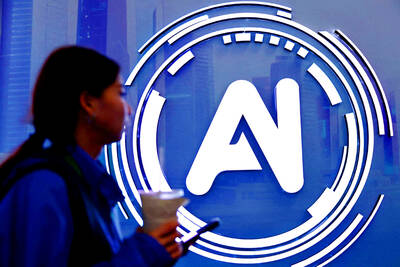The nation’s unemployment rate dropped to a two-year low of 4.92 percent last month from 5.05 percent in September after increasing private investment spurred business hirings, the Directorate-General of Budget, Accounting and Statistics (DGBAS) said yesterday.
Seasonally adjusted, the jobless rate declined for the 14th straight month to 4.96 percent last month from 5.08 percent in the previous month, DGBAS said, adding that payrolls rose 0.27 percent to 10.56 million last month from September.
“With the economy posting a robust recovery, private investment has increased and the government’s employment incentive programs continued to remain in place,” DGBAS Deputy Director Liu Tian-syh (劉天賜) told a media briefing.
The agency last week raised its GDP growth forecast to 9.98 percent for the full year after the economy expanded faster than expected in the third quarter and strong demand for exports promoted local companies to hire more workers.
Remaining optimistic about the local job market, Chen Miao (陳淼), director of the macroeconomic forecasting center at the Taiwan Institute of Economic Research (台經院), said by telephone that the robust economy was reflected in a decrease in layoffs because of fewer business closures.
“The number of employees in the industrial and service sectors also posted growth, which means companies have become more confident about the economy,” Chen said, adding that the next few months are the peak season for the service industry.
Until September, the unemployment rate had remained above 5 percent for the longest time in history, 22 months, according to the statistics bureau’s data.
Liu predicted that the unemployment rate would remain above 5 percent for the full year, as the rate averaged 5.31 percent in the first 10 months, saying that the rate would be higher than the 5.17 percent recorded in 2002 when the dot-com bubble burst.
“The unemployment rate would have reached 5.34 percent had it not been for the government’s employment incentive programs,” Liu said. “The number of jobs in public service created by the programs reached 1.05 million last month, up 93,000 from October 2008.”
The number of long-term unemployed dropped for the eighth month in a row to nearly 94,000 last month, down 4,000 from September, while the number of middle-aged people without work remained flat at 115,000, DGBAS data showed.
Looking ahead, the DGBAS predicted that the unemployment rate would continue to trend down until the Lunar New Year, despite worries that the expiration of short-term employment programs may drive the rate back up.
“Some [short-term employment programs] will continue and some will expire, but the robust growth will absorb the unemployed who had been covered by the programs,” Liu said, adding that it would not weigh on the unemployment rate.
Chen agreed, saying that manpower demand among enterprises remains robust, while playing down the impact of uncertainty over global economic growth on the local unemployment rate.

CHIP RACE: Three years of overbroad export controls drove foreign competitors to pursue their own AI chips, and ‘cost US taxpayers billions of dollars,’ Nvidia said China has figured out the US strategy for allowing it to buy Nvidia Corp’s H200s and is rejecting the artificial intelligence (AI) chip in favor of domestically developed semiconductors, White House AI adviser David Sacks said, citing news reports. US President Donald Trump on Monday said that he would allow shipments of Nvidia’s H200 chips to China, part of an administration effort backed by Sacks to challenge Chinese tech champions such as Huawei Technologies Co (華為) by bringing US competition to their home market. On Friday, Sacks signaled that he was uncertain about whether that approach would work. “They’re rejecting our chips,” Sacks

It is challenging to build infrastructure in much of Europe. Constrained budgets and polarized politics tend to undermine long-term projects, forcing officials to react to emergencies rather than plan for the future. Not in Austria. Today, the country is to officially open its Koralmbahn tunnel, the 5.9 billion euro (US$6.9 billion) centerpiece of a groundbreaking new railway that will eventually run from Poland’s Baltic coast to the Adriatic Sea, transforming travel within Austria and positioning the Alpine nation at the forefront of logistics in Europe. “It is Austria’s biggest socio-economic experiment in over a century,” said Eric Kirschner, an economist at Graz-based Joanneum

BUBBLE? Only a handful of companies are seeing rapid revenue growth and higher valuations, and it is not enough to call the AI trend a transformation, an analyst said Artificial intelligence (AI) is entering a more challenging phase next year as companies move beyond experimentation and begin demanding clear financial returns from a technology that has delivered big gains to only a small group of early adopters, PricewaterhouseCoopers (PwC) Taiwan said yesterday. Most organizations have been able to justify AI investments through cost recovery or modest efficiency gains, but few have achieved meaningful revenue growth or long-term competitive advantage, the consultancy said in its 2026 AI Business Predictions report. This growing performance gap is forcing executives to reconsider how AI is deployed across their organizations, it said. “Many companies

France is developing domestic production of electric vehicle (EV) batteries with an eye on industrial independence, but Asian experts are proving key in launching operations. In the Verkor factory outside the northern city of Dunkirk, which was inaugurated on Thursday, foreign specialists, notably from South Korea and Malaysia, are training the local staff. Verkor is the third battery gigafactory to open in northern France in a region that has become known as “Battery Valley.” At the Automotive Energy Supply Corp (AESC) factory near the city of Douai, where production has been under way for several months, Chinese engineers and technicians supervise French recruits. “They